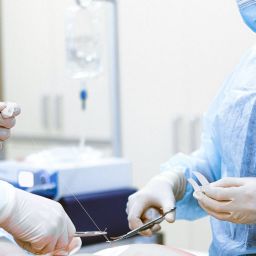Laparoscopic Surgery
Introduction:
Laparoscopic surgery, also known as minimally invasive surgery (MIS), is a surgical technique that involves making small incisions in the abdomen to perform surgical procedures. Laparoscopic surgery has become increasingly popular in recent years due to its many advantages over traditional open surgery, including reduced postoperative pain, shorter hospital stays, faster recovery times, and better cosmetic outcomes. In this article, we will provide an in-depth overview of laparoscopic surgery, including its history, advantages, indications, contraindications, complications, safety, and types of procedures.
History of Laparoscopic Surgery:
Laparoscopic surgery was first introduced in the early 1900s, but it was not until the 1980s that it became widely accepted as a viable surgical technique. The first laparoscopic cholecystectomy, a surgical procedure to remove the gallbladder, was performed in France in 1987. Since then, laparoscopic surgery has undergone significant developments and is now used for a wide range of surgical procedures, including colorectal surgeries, hysterectomies, and even cardiac surgeries.
Advantages of Laparoscopic Surgery:
Laparoscopic surgery has several advantages over traditional open surgery, including reduced postoperative pain, shorter hospital stays, faster recovery times, and better cosmetic outcomes. Additionally, laparoscopic surgery allows for more precise surgical techniques, which can lead to better patient outcomes. Finally, laparoscopic surgery results in less scarring and reduced risk of infection compared to traditional open surgery.
Indications for Laparoscopic Surgery:
Laparoscopic surgery can be used for a wide range of surgical procedures, including cholecystectomy, appendectomy, hernia repair, hysterectomy, and colorectal surgeries. Laparoscopic surgery is particularly useful for procedures that require small incisions, such as those performed on the abdomen or pelvis.
Contraindications for Laparoscopic Surgery:
While laparoscopic surgery is generally safe and effective, there are some contraindications that may make it unsuitable for certain patients. These include severe obesity, prior abdominal surgeries, and pregnancy. Additionally, patients with certain medical conditions, such as bleeding disorders or heart disease, may not be suitable candidates for laparoscopic surgery.
Complications of Laparoscopic Surgery:
Like all surgical procedures, laparoscopic surgery carries some risks of complications. These may include bleeding, infection, damage to surrounding organs or tissues, and anesthesia-related complications. Additionally, laparoscopic surgery may be associated with complications such as bowel obstruction, adhesions, and hernias.
Safety of Laparoscopic Surgery:
Laparoscopic surgery is generally considered safe, with a low risk of complications. However, as with any surgical procedure, it is essential to choose an experienced and qualified surgeon to perform the procedure. Additionally, patients should be aware of the potential risks and benefits of laparoscopic surgery and should discuss these with their surgeon before undergoing the procedure.
Types of Laparoscopic Surgery:
There are several different types of laparoscopic surgeries, including cholecystectomy, appendectomy, hernia repair, hysterectomy, and colorectal surgeries. Cholecystectomy is the most common laparoscopic surgery and involves removing the gallbladder. Appendectomy is a surgical procedure to remove the appendix. Hernia repair is a surgical procedure to repair a hernia. Hysterectomy is a surgical procedure to remove the uterus, and colorectal surgeries are surgical procedures to remove portions of the colon or rectum.
Instruments used in Laparoscopic Surgery
Laparoscopic surgery uses specialized instruments that are inserted through small incisions in the body to perform surgical procedures. Some of the common instruments used in laparoscopic surgery include:
- Trocar: A sharp instrument used to puncture the abdominal wall to create the initial access point for the laparoscope and other instruments.
- Laparoscope: A thin, lighted instrument that is inserted through the trocar and used to visualize the internal organs.
- Graspers: Long, thin instruments with grasping tips used to manipulate tissues and organs.
- Scissors: Used to cut tissue and sutures during surgery.
- Needle holders: Used to grasp and manipulate needles during suturing.
- Electrosurgical instruments: Instruments that use high-frequency electrical energy to cut or coagulate tissue.
- Suction/irrigation devices: Used to remove fluid and debris from the surgical site.
- Clip appliers: Used to apply metal clips to blood vessels or other structures to control bleeding.
- Retractors: Used to hold tissues and organs out of the way during surgery.
These are just a few of the many instruments used in laparoscopic surgery, and the specific instruments used will depend on the type of surgery being performed.
Conclusion:
Laparoscopic surgery is a safe and effective surgical technique that has several advantages over traditional open surgery. It can be used for a wide range of surgical procedures, including cholecystectomy, appendectomy, hernia repair, hysterectomy, and colorectal procedures.



